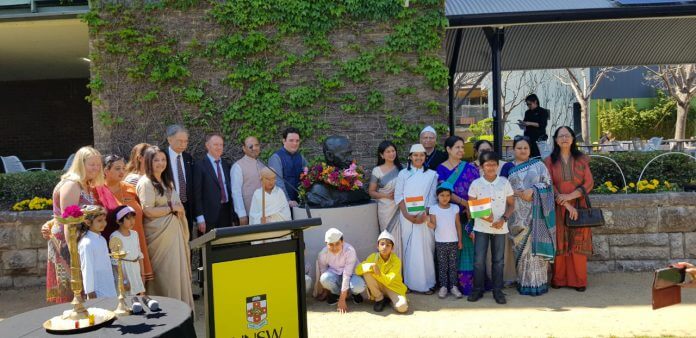
The most influential figure in humanity.
That’s how Laurie Pearcey, Pro Vice Chancellor of UNSW, chose to describe Mohandas Karamchand Gandhi.
He was speaking at the Gandhi Jayanti ceremony at the UNSW university’s Library Lawn, where a Gandhi bust takes pride of place. “Gandhi came to us at a difficult time, when division and intolerance threatened to undermine our special relationship,” he said, referring to the Indian students’ crisis of 2009-2010. “With this symbol of peace, nonviolence and inclusivity we rose above the noise to come together.”

Together with the Consul General of India Manish Gupta, he paid a floral homage to the Mahatma by garlanding his statue. In his own reflection, Consul General Gupta spoke of the continuing resonance of Gandhi’s philosophy, such as sustainable living – a pet passion of the Mahatma many decades ago.

Perhaps the most stirring moment of this annual ceremony is the re-enactment by kids of Gandhi’s famous Dandi March. Students from IABBV Hindi School Thornleigh and Darcy
Road Public School Wentworthville followed Aryan Ghelani, a young dhoti-clad, lathi-wielding Gandhi as he speed-walked across the Library Lawn. Spectators were encouraged to join, just like supporters did in 1930, taking the 24-day 400-km walk with Gandhi from Ahmedabad to the coastal village of Dandi. At their destination, as Gandhi scooped up a handful of salt with his bare hands, the course of the freedom struggle took a decisive turn.
The Mahatma was also remembered on the occasion via his favourite hymns and prayers Raghupati Raghava (Usha Sridhar and Padma) and Lead Kindly Light (Heather Lee Cunio). The little ones paid their own tribute with Vaishnava Jan To and Sabarmati Ke Sant.
The young students have played a starring role in this event for many years now: perhaps it is time their older counterparts took up the baton for a bit. The UNSW university’s 1200-strong Indian student community is yet to make a mark at this event honouring the Father of their nation.
A small subset of them, however, did rock up this year: nineteen Indian international students were formally acknowledged as scholarship winners. Also awarded on the occasion were the winners of the essay-writing competition organised by the Consulate General of India, on the topic “Be the change you wish to see in the world.” Contestants writing in the English and Tamil languages, in various age categories, were felicitated.

Later, writer Roanna Gonsalves joined Neville Roach, who had led the morning ceremony, and peace educator Margaret Hepworth in a panel discussion on Gandhi. Neville Roach spoke about how “UnGandhian” we have become in contemporary times, in terms of how we treat our Indigenous peoples, asylum seekers and our neighbours in the Pacific; our propensity to follow our ‘friends’ into war, and our unwillingness to fund public institutions such as schools and governments. “We have a lot to learn from Gandhi,” he concluded.
Margaret Hepworth of The Gandhi Experiment, a former teacher who now delivers ‘life developing’ programs based on Gandhian principles, urged people to look within, as a way of creating change. If we can create change within, we can effect change in the outside world, she noted. Her work involves teaching young people strategies to do just that.
How can we keep Gandhi’s light shining, Roanna asked. Pick one thing and fight for it, Neville suggested, describing his own unhappiness – and ultimate resignation – as immigration advisor to the government in 2002. Margaret Hepworth offered a two-step process. “Consider what you’re good at, and then consider what the world needs right now that you can help with. Combine the two and you’ll come up with the one idea that will give you a sense of purpose.” Speak up for what is not right, Roanna urged, alluding to her own into-the-street activism such as with Aboriginal rights. A thoughtful exercise, it prevailed on us all to seek out theGandhi within us.
Gandhi’s light will keep shining, literally, over the next few days and nights at UNSW, as the Library Towers light up in the colours of the Indian flag, and host an image of the Mahatma for all to see.





